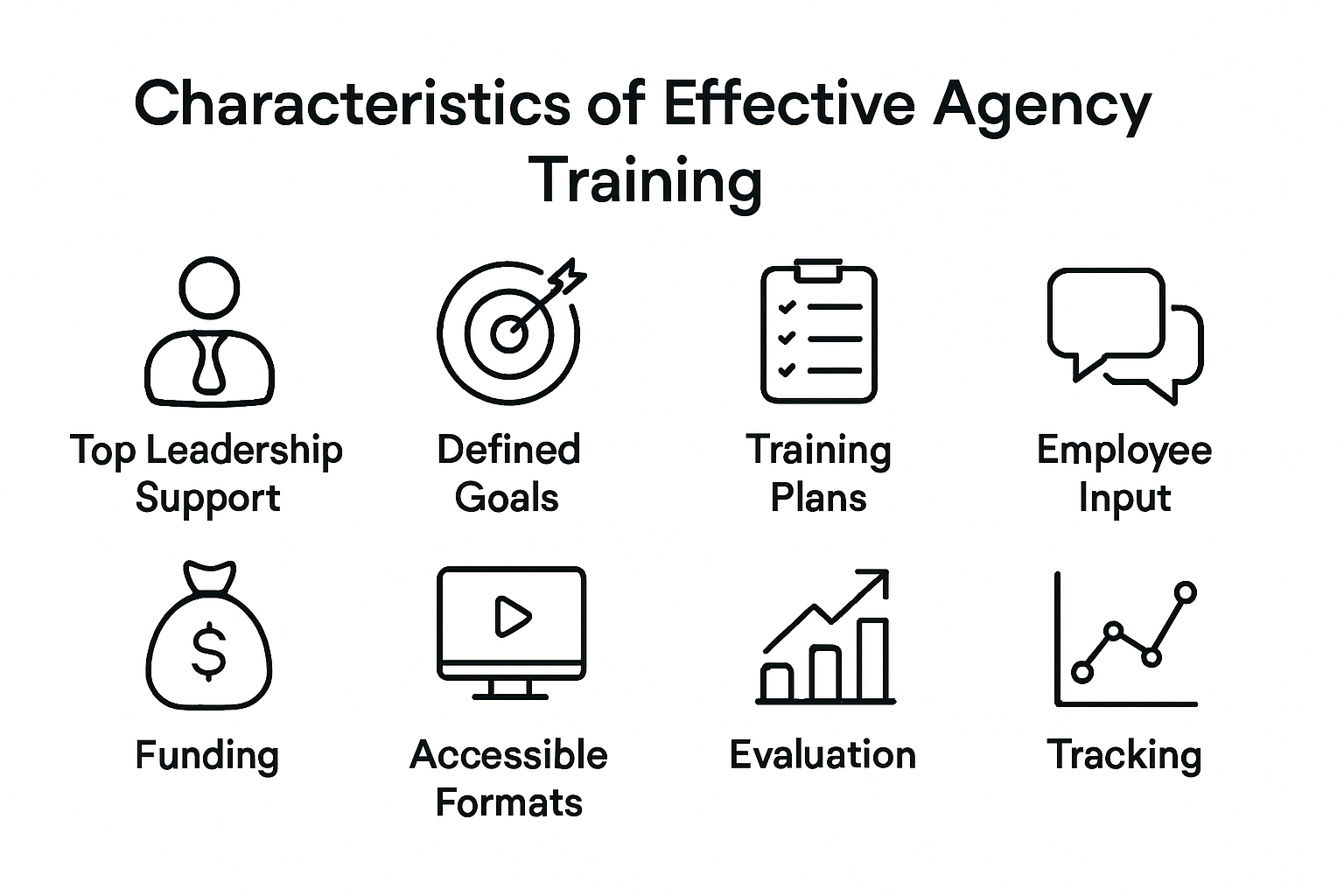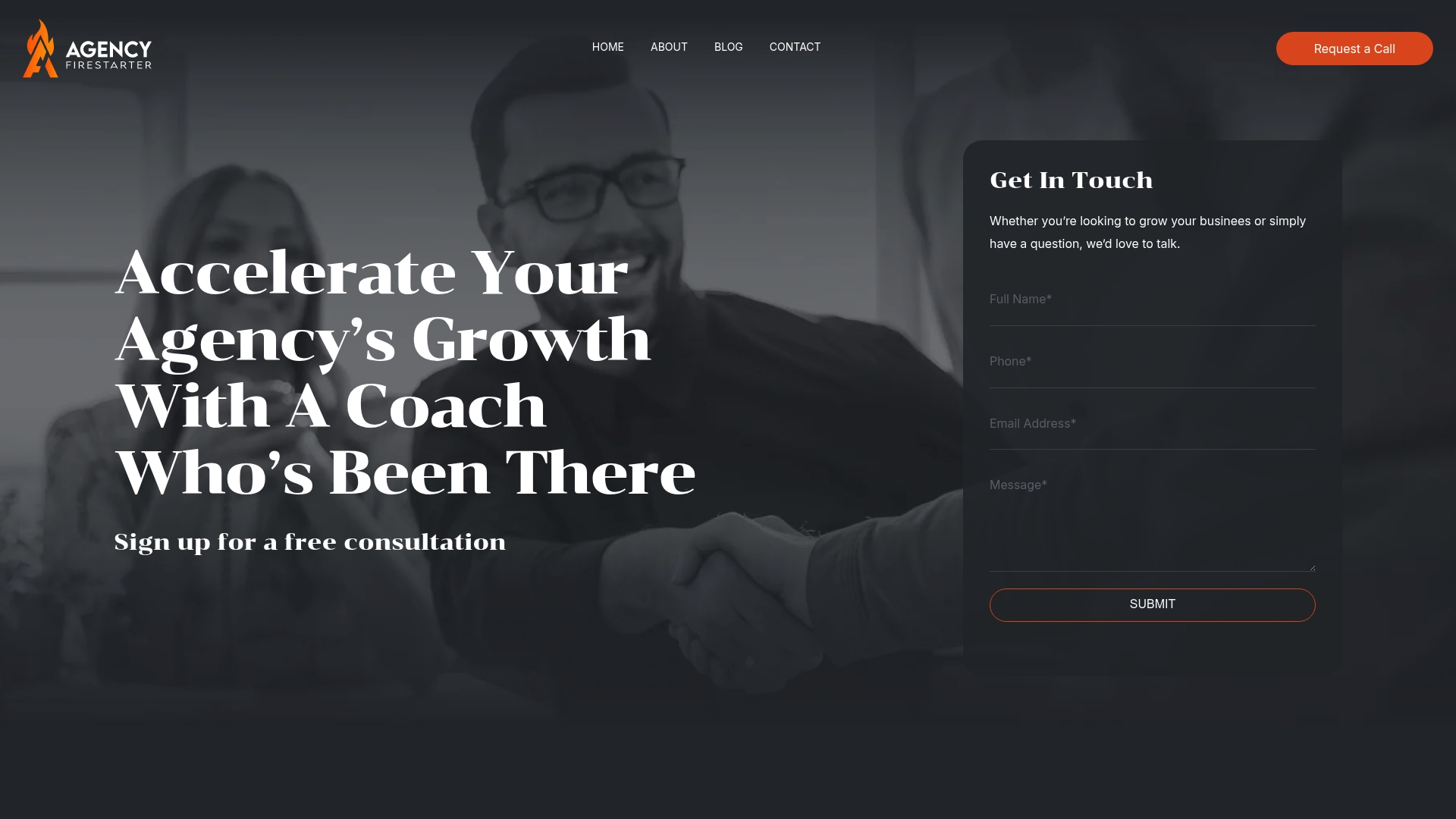
Agency Training Programs: Essentials for Growth and Success
Agency training programs promise a smarter, more capable workforce. Nearly 94 percent of employees say they would stay at a company longer if it invested in their learning. Surprised? Most agencies still treat training as an afterthought, missing out on dramatic gains in performance and retention. The real secret is that training is not just about teaching skills. It is the engine behind agency growth, adaptability, and long-term success.
Table of Contents
- Key Benefits Of Agency Training Programs
- Types Of Training Programs For Agencies
- Choosing The Right Program For Your Agency
- Best Practices For Implementing Training
Quick Summary
| Takeaway | Explanation |
|---|---|
| Invest in comprehensive training programs | Comprehensive training enhances employee skills and drives organizational success through optimized performance. |
| Focus on leadership development | Prioritize leadership training to improve talent retention and establish a strong leadership pipeline within your agency. |
| Utilize diverse training methodologies | Combine online platforms, experiential learning, and on-the-job training to address various skills and learning preferences. |
| Align training with strategic goals | Ensure that training initiatives match your agency’s strategic objectives for effective skill application and growth. |
| Implement continuous evaluation processes | Establish regular assessments to track training effectiveness, allowing adjustments and improvements to enhance outcomes. |
Key Benefits of Agency Training Programs
Agency training programs represent a strategic investment in professional growth and organizational success. By systematically developing employee skills and leadership capabilities, agencies can transform their operational effectiveness and competitive positioning.
Professional Skill Enhancement and Performance Optimization
Training programs provide a structured pathway for continuous professional development. According to the U.S. Government Accountability Office, effective training initiatives demonstrate eight core characteristics that directly impact organizational performance. These include strategic alignment with agency goals, leadership commitment, and continuous performance improvement.

Professional skill enhancement goes beyond basic technical training. It encompasses developing critical thinking, communication, problem-solving, and adaptive capabilities that are essential in today’s dynamic business environment. By investing in comprehensive training, agencies create a workforce that can quickly respond to emerging challenges and technological shifts.
Leadership Development and Talent Retention
Leadership training is a critical component of agency development strategies. American University’s Key Executive Leadership Programs highlight how targeted training prepares leaders to address contemporary challenges, retain emerging talent, and build a robust leadership pipeline.
Effective training programs serve multiple strategic purposes. They not only equip current employees with advanced skills but also create clear career progression pathways. This approach significantly improves employee engagement and reduces turnover rates. When professionals see meaningful opportunities for growth within their organization, they are more likely to remain committed and motivated.
Cost-Effective Learning and Organizational Adaptability
Modern agency training programs leverage diverse, cost-effective learning methodologies. The U.S. Office of Personnel Management emphasizes innovative approaches like on-the-job training, e-learning, webinars, and in-house training sessions. These methods allow agencies to enhance workforce skills while maintaining budgetary constraints.
Organizational adaptability emerges as a significant benefit of comprehensive training programs. By continuously updating employee skills, agencies can more rapidly integrate new technologies, methodologies, and industry best practices. This proactive approach ensures that the organization remains competitive and resilient in a rapidly evolving business landscape.
For agency owners looking to dive deeper into professional development strategies, explore our guide on leadership coaching benefits to understand how targeted training can transform your organization’s potential.
Types of Training Programs for Agencies
Agency training programs come in diverse formats, each designed to address specific organizational needs and professional development objectives. Understanding these different types enables agencies to create comprehensive learning strategies that support continuous growth and skill enhancement.
To help you quickly compare the main types of training programs available for agencies, the following table summarizes their key features and benefits.
| Training Program Type | Key Features | Primary Benefits |
|---|---|---|
| Digital and Online Learning Platforms | E-learning, webinars, virtual training, on-demand access | Flexibility, accessibility, customizable learning |
| Leadership & Professional Development | Workshops, mentorship, coaching, structured learning | Leadership pipeline, strategic skills development |
| Experiential & Practical Approaches | On-the-job training, job rotation, hands-on learning | Real-world skills, enhanced engagement |
Digital and Online Learning Platforms
The digital revolution has transformed training methodologies. According to the U.S. Office of Personnel Management, modern agencies now leverage multiple online learning approaches. These include e-learning courses accessible anytime and anywhere, interactive webinars, and virtual training sessions that provide flexibility and convenience.
Digital learning platforms offer significant advantages. They allow employees to learn at their own pace, access content from various devices, and engage with interactive multimedia resources. Agencies can track progress, assess performance, and customize learning paths based on individual skill gaps and organizational requirements.
Leadership and Professional Development Programs
Leadership training represents a critical component of agency development strategies. The OPM’s Federal Leadership Development Programs provide a comprehensive catalog of programs designed to foster advanced leadership skills across different organizational levels.
These programs typically include workshops, mentorship initiatives, coaching sessions, and structured learning experiences that develop critical competencies. They focus on enhancing strategic thinking, communication skills, change management, and emotional intelligence. By investing in leadership development, agencies can build a robust talent pipeline and prepare emerging leaders for future challenges.
Experiential and Practical Training Approaches
Beyond digital and classroom learning, agencies are increasingly adopting experiential training methods. The U.S. Department of Labor’s Employment and Training Administration highlights the importance of practical, hands-on learning experiences that directly connect skill development with real-world application.
These approaches include on-the-job training, cross-functional workshops, train-the-trainer programs, and collaborative learning environments. Such methods allow employees to develop skills through direct experience, peer interaction, and practical problem-solving scenarios. Techniques like job rotation, shadowing experienced professionals, and participation in special projects provide immersive learning opportunities.

For agency owners seeking deeper insights into professional development strategies, learn about the nuanced differences between coaching and mentoring to design more effective training interventions.
Choosing the Right Program for Your Agency
Selecting the appropriate training program is a strategic decision that can significantly impact an agency’s long-term success and competitive positioning. The process requires careful evaluation, alignment with organizational goals, and a comprehensive understanding of your agency’s unique developmental needs.
Conducting Comprehensive Needs Assessments
Effective program selection begins with a thorough training needs assessment. According to the U.S. Office of Personnel Management, agencies must evaluate training requirements at three critical levels: organizational, occupational, and individual.
The organizational assessment examines the agency’s strategic objectives, identifying skill gaps that prevent achieving mission-critical goals. This involves analyzing current performance metrics, technological requirements, and future industry trends.
Occupational assessments focus on specific role competencies, while individual evaluations examine personal skill development needs of team members.
Below is a summary table outlining the three levels of training needs assessments agencies should conduct when choosing the right training program.
| Assessment Level | Focus Area | Purpose |
|---|---|---|
| Organizational | Agency’s strategic objectives, performance metrics, industry trends | Identify broad skill gaps aligned with agency goals |
| Occupational | Specific role competencies | Determine role-based skill requirements |
| Individual | Personal development needs of team members | Address individual growth and skill gaps |
Aligning Training with Strategic Objectives
The National Academies Press emphasizes the importance of developing a clear training philosophy that directly supports an agency’s strategic plan. This means moving beyond generic training programs to create targeted learning experiences that address specific organizational challenges.
Key considerations include developing multiple delivery systems, implementing robust evaluation strategies, and ensuring effective learning transfer. Agency leaders must critically assess how each training program contributes to overall organizational capabilities. This might involve examining program curricula, instructor qualifications, potential for skill application, and measurable outcomes.
Evaluating Program Effectiveness and ROI
The U.S. Government Accountability Office recommends a comprehensive approach to training program selection that goes beyond surface-level assessments. This includes involving key stakeholders in identifying necessary skills, analyzing existing employee competencies, and considering how training investments can be leveraged across different organizational units.
Effective evaluation involves establishing clear performance metrics, tracking skill development, and measuring the tangible impact of training programs on agency performance. This may include pre- and post-training assessments, performance reviews, and long-term tracking of organizational capabilities.
Explore our strategic approach to agency business development to understand how targeted training programs can drive comprehensive organizational growth. The right training investment can transform your agency’s potential, turning skill development into a sustainable competitive advantage.
Best Practices for Implementing Training
Successful implementation of agency training programs requires a strategic and systematic approach that goes beyond traditional learning methodologies. Agencies must develop comprehensive strategies that address the complex needs of modern professional development while ensuring maximum engagement and knowledge retention.
Designing Learner-Centered Training Approaches
Effective training implementation begins with understanding adult learning principles. According to the Occupational Safety and Health Administration, successful programs leverage key characteristics of adult learners, including self-motivation, practical application expectations, and diverse learning preferences.
Learner-centered approaches involve creating interactive and dynamic learning environments. This means moving beyond passive lecture formats to incorporate participatory exercises, real-world case studies, and opportunities for practical skill application. Training programs should be designed to respect participants’ existing knowledge while challenging them to expand their professional capabilities.
Strategic Alignment and Organizational Integration
The U.S. Government Accountability Office highlights eight critical characteristics for strategic training implementation. Key among these is ensuring precise alignment between training initiatives and the agency’s overarching mission and strategic objectives.
Successful implementation requires comprehensive stakeholder involvement, leadership commitment, and clear communication channels. Agencies must establish robust accountability mechanisms that track training outcomes, recognize employee learning achievements, and create transparent pathways for skill development. This approach transforms training from a standalone activity into an integrated component of organizational growth strategy.
Continuous Evaluation and Improvement Processes
The National Academies Press emphasizes the importance of continuous assessment through the Instructional Systems Design (ISD) methodology. This approach involves systematic evaluation at every stage of training implementation, from initial needs assessment to post-training performance analysis.
Critical evaluation components include pre and post-training assessments, performance tracking, and feedback mechanisms that allow agencies to continuously refine their training approaches. Agencies should develop data-driven processes that measure not just knowledge acquisition but actual skill transfer and performance improvement.
Implementing effective training programs requires a holistic approach that balances organizational goals with individual learning needs. Understand the nuanced differences between coaching and mentoring to further enhance your agency’s professional development strategies and create more targeted, impactful learning experiences.
Frequently Asked Questions
What are the key benefits of agency training programs?
Agency training programs enhance employee skills, optimize performance, develop leadership capabilities, improve talent retention, and foster organizational adaptability by keeping the workforce updated with current methods and technologies.
How do I choose the right training program for my agency?
Choosing the right training program involves conducting comprehensive needs assessments at the organizational, occupational, and individual levels to align training initiatives with strategic objectives and identify skill gaps.
What types of training programs are available for agencies?
Agencies can utilize various training programs, including digital and online learning platforms, leadership and professional development programs, and experiential training approaches like on-the-job training to tailor learning to diverse employee needs.
How can I evaluate the effectiveness of a training program?
The effectiveness of a training program can be evaluated by establishing clear performance metrics, conducting pre- and post-training assessments, tracking skill development, and analyzing the long-term impact on agency performance.
Transform Agency Training Into Lasting Growth With Proven Coaching
Are you investing in agency training programs but still facing obstacles like slow team development, unclear leadership pipelines, or uncertain ROI from your efforts? The article reveals that even with structured training, many agency owners struggle to align learning with real business results and talent retention. These challenges can stall your agency’s growth, leaving team skills untapped and leadership potential underdeveloped.

Do not let these common pitfalls hold your agency back. At Agency Firestarter, our dedicated coaching solutions bridge the gap between training and real transformation. We offer personalized leadership development, business growth coaching, and hands-on operational strategies designed specifically for agencies. If you are ready to match training programs with actionable strategies and see measurable improvements in retention, revenue, and team impact, visit our home page now. Schedule a free consultation and discover how expert mentorship can accelerate your agency’s growth today.
Recommended
- Top Leadership Coaching Benefits for Modern Agencies – Business Coach For Digital Marketing Companies, SEO, Social Media Agencies
- Coaching Versus Mentoring: Key Differences for Agencies – Business Coach For Digital Marketing Companies, SEO, Social Media Agencies
- The Future of Leadership Development: Trends to Watch in 2025 – Business Coach For Digital Marketing Companies, SEO, Social Media Agencies
- Agency Business Development: Proven Strategies for Growth – Business Coach For Digital Marketing Companies, SEO, Social Media Agencies
